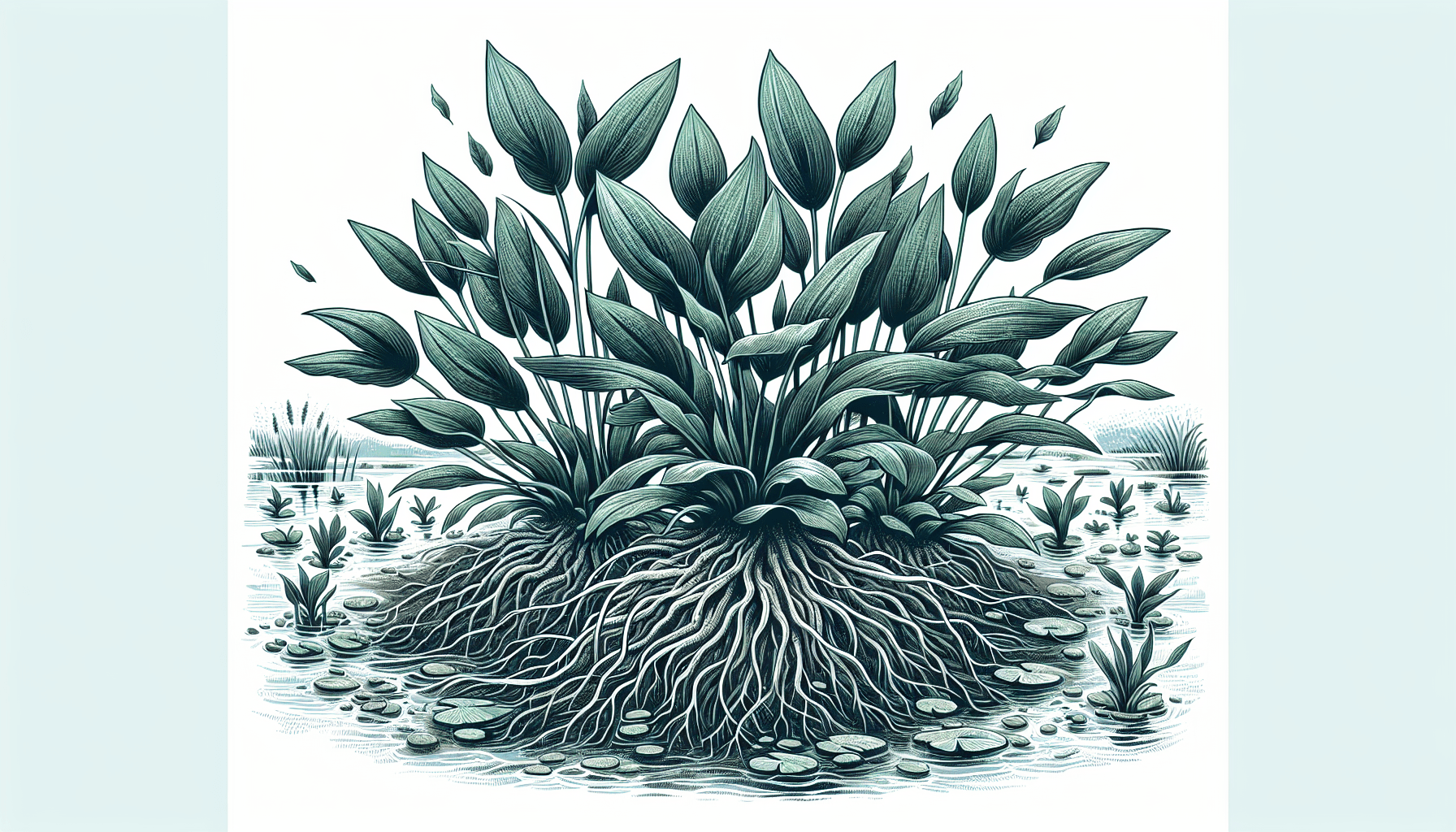In the intricate tapestry of aquatic ecology, the plant commonly referred to as Alisma, an often undesired aquatic weed, plays a pivotal role. Your comprehension of this nuanced organism, the subject of this article, will be enriched by an exploration into its botanical attributes, habitat specificity, and potential impact on the broader aquatic ecosystems. Undeniably, knowledge of Alisma not only ignites scientific curiosity but is crucial for effective management and conservation strategies in aquatic environments.
Definition of Alisma
Alisma is a botanical term that refers to a genus of flowering plants. These plants, commonly known as water plantains, are typically aquatic or semi-aquatic in nature. The word ‘Alisma’ is associated with approximately eleven species accepted globally, characterized by their presence in freshwater habitats like ponds, wetlands, and the banks of rivers.
Etymology of the word Alisma
The term ‘Alisma’ is derived from the Celtic language, rooted in the words ‘al’ and ‘is,’ which translate to ‘water’ and ‘near,’ respectively. This etymology is suggestive of the plant’s aquatic nature and its inherent association with water bodies.
Differentiating Alisma from other aquatic weeds
Though often categorized under the sweeping term of ‘aquatic weeds’, Alisma stands apart due to its distinct characteristics. A variety of unique features set it apart from other aquatic weed species, particularly in morphology, reproductive patterns, and environmental adaptation strategies.
Taxonomic classification of Alisma
In terms of taxonomic classification, Alisma belongs to the Plantae kingdom, classified under the Alismatales order and Alismataceae family. The genus itself consists of multiple species, of which Alisma plantago-aquatica is the most recognized.
Morphological Characteristics of Alisma
Understanding the morphological characteristics of Alisma can assist in comprehending its adaptability in various aquatic environments.
The leaves of Alisma
The foliage of Alisma is as distinct as its aquatic nature. Its leaves, which are generally oval-shaped, have long stalks with acuminated tips. A unique feature is that the aerial leaves are necessarily broader than submerged ones, allowing them to optimally photosynthesize.
The flowers and fruits of Alisma
The beauty of Alisma lies not only in its structure but also in its flowers and fruits. The plant produces small but numerous flowers that are typically white or pink, collected in a branched inflorescence. The fruit it bears is a small achene, which is a simple and dry fruit.
Root system and structure of Alisma
Like other aquatic or semi-aquatic plants, Alisma has a rudimentary, fibrous root system that anchors it in the muddy substrate of its habitats. This root system also adeptly absorbs necessary nutrients from both water and soil effectively.

Natural Habitats of Alisma
Having established what Alisma is and its morphological characteristics, it is crucial to study its natural habitats.
Geographical distribution of Alisma
Alisma species can be found in various parts of the world, including North America, Asia, and Europe, testifying to its adaptability to diverse climatic conditions.
Habitat preferences and adaptability
Alisma plants are mostly found in freshwater environments like ditches, ponds, marshes, or on the banks of rivers and streams. They can adapt to both standing and slow-moving waters, proving their remarkable resilience.
Seasonal growth and lifecycle patterns
In terms of lifecycle, Alisma seeds tend to germinate in spring when the temperature of water and soil has risen moderately. By early summer, the plant reaches its flowering stage and by autumn, the seeds are mature enough for dispersal.
Role of Alisma in Aquatic Ecosystems
Alisma is not a mere presence in aquatic environments. It plays multifaceted roles within these ecosystems, benefiting both its surroundings and inhabitants.
Alisma’s contributions to aquatic biodiversity
Alisma has a major role in fostering biodiversity within aquatic ecosystems. Its semi-submerged structure allows it to serve as habitat for many aquatic insects and micro-organisms, thus maintaining the intricate web of life.
Enabling nutrient recycling and oxygenation
By its incessant growth and decay cycle, Alisma aids in nutrient cycling within its habitat. Moreover, as a photosynthetic organism, it contributes to oxygenating water, thereby sustaining aquatic life.
Alisma as a food source for aquatic organisms
Alisma is known to provide a valuable food source for several aquatic animals. Its seeds are the primary diet of water birds, while grated parts are consumed by numerous other creatures.

Reproductive Techniques of Alisma
Alisma employs both sexual and asexual methods for reproduction.
Reproduction through seeds
Just like other flowering plants, Alisma’s fertile plants produce flowers which are later followed by seed set. The use of seeds for reproduction is Alisma’s primary mode of sexual reproduction, where genetic diversity is enhanced.
Reproduction through vegetative means
Besides sexual reproduction, Alisma species are known to propagate asexually as well, mostly via formation of new plants from pre-existing ones. It helps the plant colonize in a relatively shorter period but restricts genetic diversity in the process.
Impact of environmental factors on Alisma’s reproduction
The reproductive success of Alisma is sensitive to environmental factors like water temperature, light availability, and nutrient cycles, amongst others. Consequently, any changes in these parameters can influence the plant’s reproductive patterns.
Human Uses of Alisma
Interestingly, Alisma is not just an aquatic weed with ecological significance. It holds numerous human uses as well.
Alisma in traditional medicine
For centuries, different parts of Alisma have been used in traditional medicine across various cultures. It is especially valued in Chinese medicine for its diuretic properties and its use in treating kidney ailments.
Use of Alisma in landscaping and garden design
Alisma can contribute significantly to landscape and garden designs owing to its attractive semi-aquatic posture and inflorescence. It can enhance the aesthetic appeal of various water features and garden ponds.
Potential industrial applications of Alisma
Research is ongoing for exploring the potential of Alisma in industry; possibilities include its use in water filtration systems, in agroecology as a pest deterrent, or as a source of biofuel.
Management and Control of Alisma
Despite its various uses, it is important to have a strategic plan for managing and controlling Alisma to prevent ecosystem imbalance.
Impact of Alisma overpopulation on aquatic ecosystems
Overpopulation has been seen to deteriorate water quality, result in light deficiency due to dense foliage, and hinder movement of certain organisms.
Physical, mechanical, and cultural control methods
Control methods can be segmented into physical, mechanical, and cultural tactics. Physical methods can include hand weeding, while mechanical may involve the use of weeding tools. Cultural methods entail the use of certain plant species that can competitively exclude Alisma.
Chemical and biological control methods
Chemical control utilizes herbicides to check Alisma growth, although this may carry environmental implications. On the other hand, biological control, such as using certain insects or plant diseases, presents an eco-friendlier option.
Benefits and Dangers of Alisma to Aquatic Life
Albeit primarily beneficial, there are potential adversities that Alisma can pose under certain circumstances.
Alisma combating water pollution
Alisma can absorb and sequester harmful pollutants present in the water, thus acting as a natural water purifier.
Potential negative impacts of Alisma on native species
Under conditions of overpopulation, Alisma can outcompete native aquatic plant species for resources, leading to reductions in biodiversity.
Resistance or susceptibility of Alisma to common aquatic diseases
Understanding the resistance or susceptibility of Alisma to aquatic diseases is vital for managing it effectively.
Alisma and Climate Change
Climate change can have profound impacts on Alisma’s ecology, though Alisma may itself have a role in mitigating climate change effects.
Effects of increasing global temperatures on Alisma
Rising temperatures due to climate change could influence Alisma’s growth patterns, potentially making it more prolific.
Impact of changing water levels on Alisma populations
Changes in water levels, whether due to alterations in precipitation patterns or rising sea levels, could impact Alisma populations by affecting its habitat extent and quality.
Potential role of Alisma in climate change mitigation
As a carbon sequestering plant, Alisma can absorb carbon dioxide from the atmosphere, thereby playing a role in climate change mitigation.
Future Research Directions for Alisma
To fully harness the potential of Alisma and manage its disadvantages, future research directions have been suggested.
Genetic studies and breeding of Alisma
A deep understanding of Alisma’s genetic structure could pave the way for selective breeding with desired traits, such as pollutant absorption capabilities or resistance against disease.
Exploration of Alisma’s medicinal properties
Further research into Alisma’s medicinal properties could add value to it as a raw material in the pharmaceutical industry.
Ecological role of Alisma under changing environmental conditions
Understanding how Alisma reacts to changing environmental conditions, and how it can play an effective part in maintaining the health of aquatic ecosystems, is a significant research direction as we continue to face the impacts of climate change.
In conclusion, Alisma, though an aquatic weed, holds notable potential. By understanding and further exploring the plant’s ecological role, medicinal properties, and potential applications, we can utilize Alisma to benefit both aquatic ecosystems and human societies.